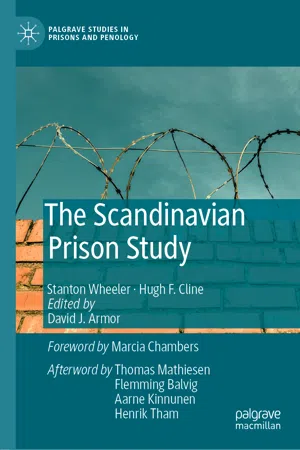This volume reports the results of a study of fifteen prisons in the Scandinavian countries. The prisons range in age from old bastilles built in the mid-nineteenth century to new modern institutions built in the latter part of the twentieth century. They also range in purpose and design, in style, and in the way they are staffed and managed.
The prisons are inhabited by almost two thousand inmates. They, like the prisons they inhabit, are a varied lot. Some are young, some are old, some are married, and some are single. Some have never seen the inside of a prison before, and others have been behind bars for a decade or more.
A central purpose of our study is to learn more about the phenomenon of imprisonment by examining variations, both in the prison and in its inhabitants. In the first major substantive part of our study (Chapters 3 and 4) we shall examine closely the differences between the fifteen prisons, with our focus on the prison itself rather than on its inmate inhabitants. We shall endeavor to describe differences between the prisons in some detail, and hopefully to suggest what effects those differences have on the social climate of the prison. In a second major section of our study (Chapters 5 and 6) we focus attention not on the prison but on its individual inhabitants, the inmates. Here we try to describe and explain differences in inmate response to the prison based both on qualities the inmate brings with him into the prison and on the nature of the life he comes to lead while inside.
In a third major section (Chapters 7 and 8) we put together these two levels of analysis, attempting to say what we can about the extent to which individual inmate responses to the prison are a function, not only of the inmate himself, but of the nature of the type of prison in which he is confined. Finally, in a fourth and final section, we take up a number of issues that have concerned penologists for some time: the effect of adopting a psychiatric approach within the confines of a custodial prison, cross-national differences in the nature of inmate life and culture, and the nature of socialization within the prison.1
A basic assumption underlying our inquiry is that much can be learned about the nature of prison life from a study of inmate responses to different types of prisons. Our aim is to produce generalizations about the prison and its inhabitants. We are not primarily concerned with an immediate input to social policy, either with reference to the particular institutions we studied or to others. Many of the institutions have changed since we originally studied them some fifteen years ago (in ways we describe in an epilogue) but our purpose even then was not to solve some immediate administrative problem. Our hope is to learn something basic about the nature and structure of prisons, about the effect of that structure on individual prisoners, and on the other factors that may influence the way they respond to confinement. We do feel some inferences about prison policy may be drawn from some of our findings, and we detail these considerations in a concluding chapter. But our primary aim is a more basic description of an explanation of prison phenomena, as they may be understood through the use of systematic social research.
In form, this study could have been carried out wherever inmates inhabit prisons. In fact, it was conducted in the distinctive territory of the world known as Scandinavia, including Norway, Denmark, Sweden, and Finland. And since both institution and inmate are likely to be shaped by their surrounding culture, we shall devote most of the remainder of this chapter to a description of the most salient features of the Scandinavian countries, and the differences between them. Before doing so, however, we pause briefly to locate our type of inquiry among the varied types of writings on the prison.
Perspectives on the Prison
The seemingly endless stream of writings on the prison in recent years gives evidence both of the symbolic importance of imprisonment as our most severe form of punishment short of death, of the dramatic qualities of prison life, and of the enormous range of practical questions facing those who would improve the functioning of prisons. Although there are innumerable ways of classifying the literature in the field, for our purposes this vast body of reports, studies, and accounts can be divided into four general types. We do not intend anything remotely approximating a full review of each of these types of writing, but we do want to describe what lies at the core of each, in order to make clear where our own work might be placed in reference to that of others.
Perhaps the most important writing in terms of sheer volume falls into what might be called policy-oriented studies. These studies will run the gamut from brief reports prepared for a given state correctional system concerning some aspect of prison administration to broad and synthetic studies bearing upon prison policy. Among the latter would be included, for example, the report of the President’s Crime Commission, Jessica Mitford’s review of the California prison system, The American Friends’ Service Committee’s report on prisons, and the report of the Special Committee formed by Senator Goodell.2
Also important in this category are technical studies designed to answer particular questions of prison policy. Such studies might include the most appropriate way to classify inmates, the nature and effects of the parole system, the effects of treatment programs, the general relationship of imprisonment to recidivism, or the development of criteria for deciding when a person should be released from prison.3 Another important type of policy-oriented study is that of the investigative commission, typified in fairly recent American experience by the Attica Commission Report.4
Some of these studies have been conducted by lawyers, some by sociologists, some by stati...
